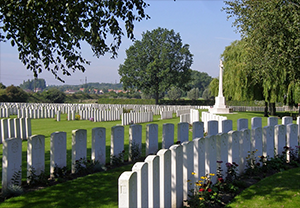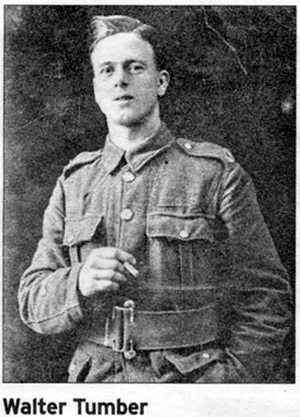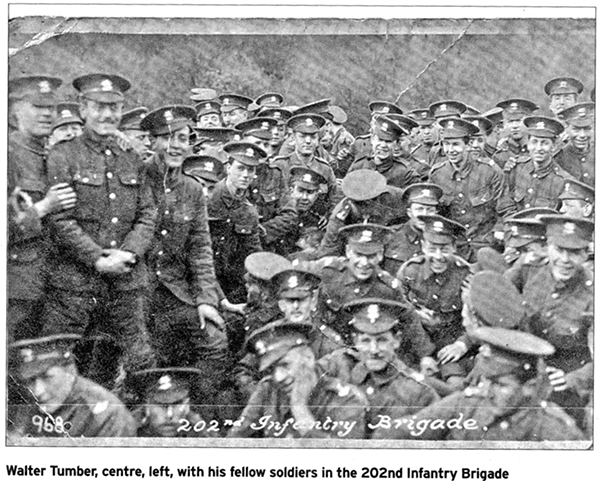First World War Project
Charles Albert TUMBER (of Teynham)
b. Q2 1895 (bapt.1st May 1895) Sergeant, Service Number 7102 |

Albert was christened Charles Albert and appears at times as "Charley A" (1911) and "Charles Albert", but he generally used only his second name. Albert's extended family had very strong associations with Kingsdown and then Lynsted (where his grandparent's, Alfred and Eliza, lived.) Albert's parents, Frederick and Minnie, made their first marital home next-door to Frederick's parents living in Champions Cottages, Greenstreet (Lynsted side).
For a short time (1901 Census), Albert's father lived at 9, Stayton Road, Sutton, Surrey, working as a "general labourer". Two of his children (William and Albert) along with their cousin Edward Tyrrell were left with their grandparents, living next to "The Hollies" in Greenstreet (Lynsted Parish side) while Walter stayed with his father. Mysteriously, Minnie and her daughter Anne (b.1900) drop out of census records for 1901 - perhaps a transcription error? However, by 1916, his mother, Minnie, is found again at 7 Frognal Lane, Teynham, which explains why his name is found on the Teynham War Memorial. Minnie was Albert's sole legetee, receiving £18 13s. 3d. plus a War Gratuity of £13 10s. This War Gratuity confirms his enlistment in August 1914. [See Appendix 2]
The 1911 census tells us Albert, born in Teynham, was one of seven surviving children of Minnie and Frederick Tumber (4 having died in infancy). He had an elder brother (William or "Bill"), and 5 younger siblings (Walter T, Ann, Arthur Victor, Beatrice, and Leenene). The recollections of Doris Sivyer, daughter of Walter Tumber (see below), tell us there were thirteen children, so it may be that census data gives an incomplete picture (e.g. dates after 1911 are not covered).
| East Kent Gazette of 21st December 1918 |
IN MEMORIAM TUMBER. In ever-loving memory of Sergeant Albert Tumber, 1/19th London Regiment, second son of Mr. and Mrs. Frederick Tumber of 7, Frognal Lane, Teynham, who was killed in action in France, December, 1916, aged 22 years.
|
Military Records
Albert served on the Western Front after joining 1/19th (County of London) Battalion (St Pancras) from 4th East Kent Regiment. Records of Regimental Numbers suggest Albert joined the London Regiment on or just after 7th August 1916. His medal card also tells us that he was first posted to France on 1st September 1916.
The medal card also shows Albert was "formerly #1399, 4th East Kent Regiment". If he was part of 2/4th East Kent Regiment, this Home-based Regiment would have provided training but no overseas service. Like so many before him, Albert may have decided that he had to take the initiative to speed-up his overseas service by joining a Regiment in great need of recruits to build its numbers ready to serve in France.
He was one of 98 soldiers from the same London Battalion who are remembered and buried in the Railway Dugouts Burial Ground. His headstone reads "Loved by all, not forgotten"
He earned the British War and Victory Medals. [See Appendix 1]
1/19th Battalion of the London Regiment (St Pancras)
This Regiment first travelled to France on 10th March 1915 to join the 5th London Brigade, 2nd London Division. On 1st August, when Albert attested to the London Battalion at Home, the 19th Battalion was moving from Buneville, marching to Bonnieres for training before moving on to Hiermont Noyelles-en-Chausse for additional training. They marched off again to Bresle and further training. This was the location of the Battalion as Albert landed in France on 1st September. Unusually, the Battalion Diary fails to register any drafts of new men - we can assume Albert joined he new unit soon after landing.
6th to 9th September: "Battalion took part in Divisional Attack Practice at FRANVILLERS on ground plotted out to represent HIGH WOOD; a wood of convenient size being the groundwork for the scheme." Prior to taking part in the Somme offensive.
So, Albert arrived as the Battalion began its involvement in the faltering Somme Offensive following extensive periods of training - but with limited and costly effect.....
On 11th September, 8.00 a.m., "Battalion moved to support area in trenches FRICOURT and MEMETZ WOODS taking over from 1st GLOSTERS (1st Division). Casualties Nil."
Following Orders, on 14th September the Battalion moved to support trenches (MILL STREET) at BAZENTIN-LE-GRAND, taking over from 24th London Regiment. HQ moved to HIGH WOOD ahead of the advance, preceeded by "Tanks" - "two of these on Battalion front, which were put out of action before the battalion left their assembly trenches. One received a direct hit while the other was unable to surmount the difficulties of the ground." At 6.20pm "Zero. 17th and 18th Battalions advanced into NOMANS LAND but behing held up by Machine Gune fire were unable to proceed."
"(Zero + 40) 19th and 20th Battalions left their assembly trenches and pushing forward under heavy enfilage dire from left found that the breceding battalion had been unable to gain ground, with the result that elements of all 4 Battalions congested in 0.B.1 and 2 and in this communication trench. At this point the Commanding Officer left his H.Q. to restore order. To do this he clambered out of the communication trench calling upon men to follw and was killed almost immediately by Machine Gun bullet. Captain TRIM assumed temporary command of the Battalion, since Captain KERSHAW was missing. While the trenches were being cleared of dead and wounded and the men in them being reorganised a second barrage this time on 0.G.I was asked for. Bombing attacks were organised under 2nd Lieutenants CRUMP and CHANDLER to work up the flanks of the wood. 10.30 a.m. These attacks were launched successfully, many Germans surrendering and the remainder vacating the position.
10.45 a.m. A second frontal attack was launched without opposition and consolidation of 0.6.I. was begun. A signal station was at once opened in 0.6.I. which with the exception of a short while during the night maintained communication wile the Battalion was in HIGH WOOD. By 11.00.p.m. the wood was reported clear of the enemy." Consolidation followed on 15th September while under heavy shelling overnight. 10 officers killed. 2 officers wounded. Other Ranks: killed 66, wounded 211, missing 16. Of those injured, one officer died of wounds as did 5 O.R's. Further casualties occurred after relief when the troops had to return to MAMETZ WOOD as there were no billets available. On 18th September the Battalion moved to BAZENTIN. In BRESLE, large burial parties were provided over the next two days before returning to BAZENTIN to relieve the 8th Berkshire Regiment. Then relieving the 2nd K.R.R.C. in FLERS LINE (28th September) south-east of EAUCOURT LABBAYE with Company in FLAG TRENCH. For the remainder of the month, they were bombarded heavily in FLERS LINE alongside the 19th, 20th London Regiments and the 2nd Battalion New Zealand Rifle Brigade.
October opened with a Battalion attack in 4 waves, supported by a creeping barrage that drove Germans 100 yards back. Held up by machine gun fire, the Battalion waited until "Tanks" arrived and further progress. By 3rd October, it was reported that the enemy had evacuated FLERS LINE. But all ground gained was immediately the subject of sustained shelling.
So, Albert arrived at a time of very heavy and costly fighting; part of the ongoing Battle of The Somme. This latter period cost a further 2 officers' and 38 Other Ranks' lives (3 more died of wounds).
Firstly in QUADRANGLE and then FRANVILLERS, the Battalion was relieved out of the trenches to reorganise, take on 19 more Other Ranks in a draft. A feature of October was the lack of rations being provided from time to time. The Battalion then moved to billets at GORENFLOS and then to GODEWAERS-VELDE and then STEENWOORDE and the weather turned nasty. The Battalion marched to billets and training in BUSSEBOOM ("Devonshire Camp") on 21st October to 30th October.
From 30th October, the Battalion moved into Trenches in BLUFF SECTOR where carrying parties were busy day and night. Dry socks and coffee were provided every night as the weather continued to be very wet. On 8th/9th November, the Battalion relieved the 20th Battalion on the Right-sub-sector of BLUFF SECTOR in immediate support of Tunnels. Generally, the next few days were engaged in improving and draining front line trenches. Without movement, these days were spent shelling and being shelled, suppressing fire in both directions from time to time. They suffered some casualties in this period from shelling of trenches.
On 19th November, the Battalion moved back to DEVONSHIRE CAMP to clean up.
Circumstances of the death of Sergeant Albert Tumber
The Battalion remained in billets (training) until 28th November when they relieved the 6th London Regiment in Support Trenches for RIGHT SECTOR LUFT SECTION - distributed as, 1 Company at BATTERSEA FARM, 2 Platoons FOSSEWAY; 2 Companies CHATEAU BELGE and 2 Platoons to RAILWAY DUGOUTS. 2 light machine guns attached to each Company and 1 section of Bombers. Battalion H.Q. was set up in RAILWAY DUGOUTS. The Scheme was issued by Brigade on 1st December with Pioneer Plattons organised for special work under Royal Welsh Fusiliers.
1st and 2nd December: TRENCHES, HILL 60 SECTOR: Battalion in Support as follows. Battalion Headquarters RAILWAY DUGOUTS.
1 Company BATERSEA FARM - 1 Company RAILWAY DUGOUTS - 2 Companies BELGIAN CHATEAU.
3rd to 7th December: as above: Battalion relieved 20th Battalion in Front Line (RIGHT SUB SECTOR). Casualties Nil.
8th December: as above: One Other Rank wounded.
9th December: Battalion relieved by 20th Battalion and moved into Reserve at HALIFAX CAMP. Casualties Nil.
10th to 14th December: HALIFAX CAMP: Working Parties provided by Battalion. Casualties Nil.
15th December: TRENCHES HILL 60: Relieving 20th Battalion in Front Line. Casualties Nil.
16th December: as above: Casualties: 2nd Lieutenant H.B. MARR killed in action. 3 Other Ranks killed, 3 O.R.s wounded.
This begs the question, did Albert die of wounds (inflicted 8th December)? Usually, this would be reflected in the terms of the Register of Effects and CWGC commemoration. So, was the War Diary wrong? We have found the War Diaries to be wrong before. So, we would suggest the death date was correct and the record of 16th December, included Albert's death. The Battalion Diary is very cursorily kept - with no details given of any actions, even when casualties were recorded. It begs the question, how well were records being kept.
On the anniversary of Albert's death, an Obituary was published:
| East Kent Gazette of 25th December 1917 |
SERGEANT ALBERT TUMBER, LONDON REGIMENT. Sergeant Albert Tumber, the second son of Mr. and Mrs. Frederick Tumber, of 7, Frognal-lane, Teynham, was killed, in action in France on December 16th, 1916, and opportunity is taken on this the first anniversary of his death, to publish the portrait of this fine young soldier.
Two other sons of Mr. and Mrs. Tumber are serving – one is in the Royal Engineers at Canterbury, and the other is now in Italy with the Royal Warwickshire Regiment. The latter young man has over two years' service to his credit. The late Sergeant Tumber was well known in Teynham and Sittingbourne, and his early death was much regretted. |
Extended Family in the War
William Thomas Tumber
Served and survived. Attested in 1914 to join the 4th Battalion, Royal Engineers, 67th Divisional Signal Company. Attested number 538235.
Walter Tumber, brother, who survived.
Recollections from his daughter make poignant reading. Published in the Sittingbourne News Extra of 23rd September 2015:
Girl didn't know soldier
 Young Doris Tumber watched the man walk down the platform at Teynham station towards her.
Young Doris Tumber watched the man walk down the platform at Teynham station towards her.
She had been told by her mother that this was her father, returning from war after four long years, but he was a stranger to her.
The poignant tale of a father meeting his daughter for the first time almost a century ago was shared by Doris, now Mrs Sivyer.
She clearly remembers the meeting at the station at the end of the First World War, even though she was very young.
Mrs Sivyer, who will be 100 in April, called after seeing the photograph of three children in the hop garden (SNE, September 9).
"Two of them are my cousins, Trevor and Daphne Buttle," she told me.
"They lived in a bungalow at the bottom of my gran's garden in Frognal Lane. My mother and I lived with my gran while my father was away in the war."
Trevor and Daphne's mother was Beatrice Buttle (née Tumber), the youngest of 13 children, of which Mrs Sivyer's father Walter was third in line, after Bill and Albert, who was killed in the war.
She believes Daphne, who is about five in the photograph, later went to Scotland and Trevor, who is about three, married and lived in Staplehurst Road, Sittingbourne, but has since died.
The Tumber family frequently went hop picking and Mrs Sivyer remembers it as a sociable pastime, with families and friends chatting over the bins.
She said her gran also picked cherries, but fell off a ladder and died from complications resulting from her injuries.
Mrs Sivyer lent me this splendid photograph of Walter in his uniform and another of him with his comrades.
When he returned from the war he got a job as chauffeur to the managers of Sittingbourne Paper Mill and would sometimes bring the limousine to the family home in Murston to show his daughter.
She recalls that her father also rode a motorbike, on which she travelled as pillion while her mother was in the sidecar, on their frequent trips to see relatives in London.
Walter was a fine pianist and could play by ear. His daughter inherited a musical talent and was sent for lessons when she was six.
She later taught the piano to children in Murston and has happy memories of her young pupils. She still enjoys listening to music, but can no longer play because of arthritis.
Mrs Sivyer met her husband Gordon at a dance in the Welfare Hall in Murston and they married in 1939.
He worked for the Naafi when he was called up in the war and travelled extensively, before returning to work in the Cooperative's chemist in East Street, Sittingbourne."

Draft Family Tree for Albert Tumber

Additional Documents - Creekside Cluster Men who served in Battalions of the London Regiment
Eleven of our Creekside casualties served in London Regiments (several having initially enlisted into one of the County Battalions The Buffs (East Kent Regiment) or the The Queen's Own (Royal West Kent Regiment). These postings all took place in the latter half of the First World War and may have been drafted from a Kent Training Battalion into depleted London Regiments.
| Faversham and North East Kent News of 4 December 1915 |
Text |
| Faversham and North East Kent News of 4 December 1915 |
Text |
| Faversham and North East Kent News of 4 December 1915 |
Text |

 World War 1 Pages
World War 1 Pages